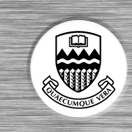







|
Murray R Gray
Graduate Research Projects (2005-2006)
Selective Separation of Bitumen Components
The current technologies for separating bitumen are distillation and precipitation of asphaltenes. Neither of these processes are selective for the undesirable components of the bitumen, including organometallic compounds and nitrogen compounds in the vacuum residue fraction and sulfur compounds in the distillates. In collaboration with the Imperial Oil Centre for Oilsands Innovation, we are exploring new approaches to removing unwanted components from bitumen-derived streams.
Kinetics and Transport Processes in Upgrading of Bitumen
In partnership with Syncrude Canada, we are investigating the fundamental processes involved in cracking high-viscosity bitumen into much more valuable products. Key areas where graduate students can make significant contributions include:
-
How can thermal reactions be controlled to maximize the yield of desirable light liquids and minimize solid carbonaceous byproducts? Recent work has shown that diffusion and reaction in the liquid phase are highly coupled, and that fluid properties change dramatically during the cracking and coking reactions. These observations emphasize the need to better understand the reverse reactions that suppress the yield of desirable components, and how to control liquid-phase mass transfer resistance in commercial reactor processes. By using induction heating, we are able to observe reactions of thin films of bitumen, determine the duration of liquid phase behavior, measure the physical properties, and investigate the role of pressure, composition and temperature. Videos of these experiments are available for viewing on my web site. Addition of tracer compounds or stable isotopes provides a probe into the chemistry of forward and reverse reactions. In one exciting new approach, we are synthesizing compounds with known structure in order to understand better how the bitumen components behave. The challenge is to then integrate these fundamental observations to determine how fluid properties and reaction kinetics combine to control conversion at commercial scale, and use this insight to develop innovative approaches to upgrading. We are particularly interested in extending measurements of intrinsic kinetics to temperatures over 600 ° C, which requires careful consideration of the transport processes.
-
How do transport processes in multiphase reactors affect the yield of desirable products? Cracking in fluidized beds involves the physical interaction of hot solid particles with liquid feed material. Transport processes such as heat and mass transfer can control the course of the reaction and the yield of products. This project is investigating the behavior of agglomerates of solid particles and liquid feed at reactor conditions in order to gain a better understanding of the controlling rate processes.
These projects involve collaboration with Syncrude Research and with Dr. William McCaffrey.
Bioprocesses for Hydrocarbon Conversion
Bacteria and fungi can modify hydrocarbons for use as nutrients for growth. These processes are very important for two reasons:
In both cases, the transport of reactant into the cell and it subsequent enzymatic conversion are very important processes. In the former case, the desired end product is carbon dioxide and more cells, while in the latter case we seek to stop degradation much earlier. In collaboration with Julia Foght (Biological Sciences), we are studying the processes for uptake of these compounds by cells, how they are transformed, and how the transformed products are excreted from the cells. When we wish to control the products from microbial attack to maximize the value of the products, then molecular biology allows selection of appropriate mutants with desirable characteristics.
Graduate students are making invaluable contributions in this area. Recent work by Beth Hearn identified the gene for a novel transport protein that is able to selectively pump some aromatic hydrocarbons but not others. In the area of selective reactions using bacteria, Kathlyn Kirkwood is characterizing new organisms which are active against the aliphatic sulfur compounds. Loredana Dorobantu is examining the process of attachment of cells to oil-water interfaces, and the formation of emulsions that are stabilized by bacteria, while Hasan Abbasnezhad is investigating how we can control such attachment by adding selected compounds to the medium. In collaboration with Dr. Tony Yeung, student Kang Zhewen is studying how the formation of a bacterial layer affects interfacial properties and flow through porous media. Future research will integrate the understanding of enzymatic reactions, transport across cell membranes and multiphase bioreactor behavior in order to develop novel bioprocesses.
|













